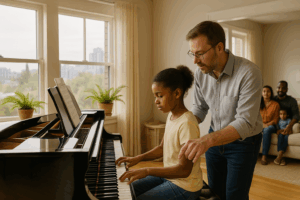As a team of independent Seattle piano teachers specializing in in‑home lessons for beginner students, each of us uses slightly different strategies—but we all agree on one thing: how you practice at home makes all the difference. When students reliably practice piano at home Seattle, their growth accelerates, motivation increases, and lessons make more sense.
Here are six practical methods we use to turn practice time into musical progress.
Teacher A (Amanda): Define Small Phrases, Big Gains
“One phrase at a time—that’s how I teach students to conquer pieces quickly.”
- I ask students to identify a musical phrase (like a sentence in speech) and work just on that.
- Use the “4‑3‑2‑1 trick”: pause before a tough transition, count down rhythmically (4, 3, 2, 1), then play through. It helps smooth out tricky spots.
- Aim to master each phrase slowly before trying full tempo.
Teacher B (Ben): Simplify and Slow It Down
“I remind students: slower is smarter.”
- Break down difficult sections and simplify them—reduce tempo, remove notes, loop rhythm.
- Focus on clarity rather than rushing through.
- Use metronome settings below performance speed to build precision.
Teacher C (Claire): Practice with Purpose, Not Just Time
“Consistency beats duration—especially with beginners.”
- Encourage daily practice, even just 10 minutes.
- Practice warm-ups, scales, new repertoire, then end with something enjoyable.
- Students see more progress practicing frequently than in infrequent long sessions.
Teacher D (Daniel): Mix Warm-Ups, Technique, and Creativity
“I like to structure practice: warm-up → technical study → new piece → creative time.”
- Warm-up (5 minutes): basic finger drills.
- Technique (10 minutes): focus on scales, small exercises.
- New material (15 minutes): play slowly, break into sections.
- Fun time (5 minutes): improvise or experiment.
This variety keeps focus and encourages creative flow.
This variety keeps focus and encourages creative flow—especially when paired with strategies like the ones we shared in our post on Five Practice Tips Every Piano Student Needs to Know.
Teacher E (Elena): Set Goals and Reflect
“At the end of each practice I ask: ‘What felt easier today? What was still hard?’”
- Students choose one goal per session: cleaner transitions, steadier rhythm, smoother chord changes.
- Weekly reflection helps track progress and build confidence.
Teacher F (Felix): Music Theory Meets Practice
“I teach a bit of theory alongside practice to deepen understanding.”
- Understanding notation, chord structure, and phrasing helps students target their practice more effectively.
- When they see why something sounds off, they fix it faster.
Benefits of Practicing with These Methods
- Structured progress: steady improvement over time
- Reduced mistakes: fewer frustrations, stronger technique
- Creative engagement: practice becomes enjoyable, not repetitive
- Academic support: enhanced focus and discipline transfer to school
For more about building effective piano habits, see our blog on Best Piano Practice Routine for Kids and Beginners.
FAQ – Practice Strategies Answered
Q: How often should a beginner practice, and for how long?
A: Short daily sessions (10–20 minutes) are far more effective than longer, occasional ones. Consistency builds habits and muscle memory.
Q: Should beginners always start at the beginning of a piece?
A: Not necessarily. It’s often helpful to begin in the middle or end to avoid neglecting those sections. Focus on trouble spots first.
Q: Is it okay if a student wants to improvise instead of practicing notation?
A: Absolutely. Including creative free-play or improvisation helps motivation and musicality—and works well as a reward during structured practice
